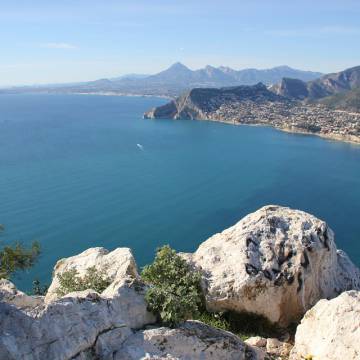Calpe
CALPE
Visits in Calpe
Calpe is located just 30km from Denia. From the road, the imposing Peñon de Ifach stands out. The imposing Peñón de Ifach (the Ifach Rock), Spain declared this a Natural Park in 1987.
The Peñón de Ifach. Climb up to the summit of the Peñón to enjoy the beautiful views. At the start of your climb you will find the Centro de Interpre-tación Peñón de Ifach, (The Visitors’ Nature Centre) where information is displayed about the Country Park in exhibitions and audiovisual shows (on re-quest)and “La Pobla d’Ifac”, medieval settlement (13th century).You will be amazed at how big the Peñón de Ifach actually is; its imposing shape reaches a height of 332m, as it rests in the Mediter-ranean waters far below. At the summit we are surrounded by incredible views, the immensity of the sea, the reflection in the water of Calpe itself, and all the nooks and crannies of the rocky coastline. The Ifach is also a favourite destination for rock climbers and deep sea divers.
The archaeological remains of "Los Baños de la Reina" (The Queen´s Baths"), dating from II-V centuries, are located between Calpe town and the Peñón; these remains of a Roman villa formed part of a fish factory which, as you will see, is still in a good state of preservation.
Visit to Calpe
In the old town you will find the "Torreó de la Peça", which houses the architectural remains of a military fortress dating from the end of the 14th century. These remains were reinforced in the 18th century by order of Felipe III and further restored in 1981. Nearby are the "murallas" (XIV and XV centuries), and the"Forat de la Mar", which is a gateway into the town opened by the French troops in 1813. "La Iglesia Antigua" ("The Ancient Church", is the only example of Mudéjar Gothic architecture in the Valencian Community, and "la Iglesia Parroquial Ntra. Sra. de las Nieves" ("The Parish Church of Our Lady of the Snows") is of great interest for its stained glass windows and its façade decorated with mosaics.
Next you can make your way to the “arrabal” and visit the Museum of History and Archaeology, the Fiesta’s Museum and the Contemporary Art Gallery.
In the centre of the old town you will find la Casa Cocó, a typical rural style house of the Marina Alta, el Llavador de la Font, the old fountain and laundry area for the village, and various buildings designed by Ricardo Bofill in the sixties and the eighties in “La Manzanera” urbanization.In other parts of the town you can visit the San Salvador and the San Juan chapels (18th century), and the 19th century Pou Salat.
Coastal walk
Parallel to the coast are the promenades and walkways known as the Infanta Elena promenade, along the Arenal-Bol beach and the Infanta Cristina promenade, along the Levante or La Fossa beach. The Prince of Asturias Promenade is situated at the foot of the Peñón de Ifach, bordering the southern slope.


